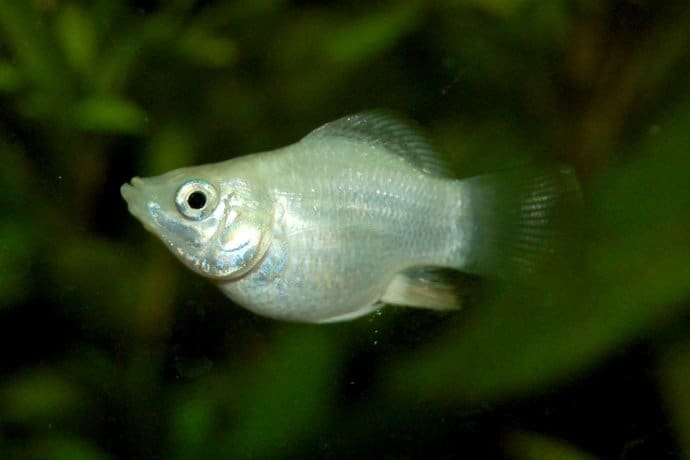Guppies are popular tropical, live-bearing fish that belong to the Poecilid family. These prolific breeders are often referred to as million fish. Because they are found in an assortment of colors, fin types, and patterns, they may also be called rainbow fish. Guppies are widely available in pet stores, often at a cheap price and in abundance.
Another major factor that draws people to guppies is that they are highly compatible fish. Guppies are very peaceful and social. They have over 20 compatible tank mates, which we discuss in this article.
Guppy Fish Overview
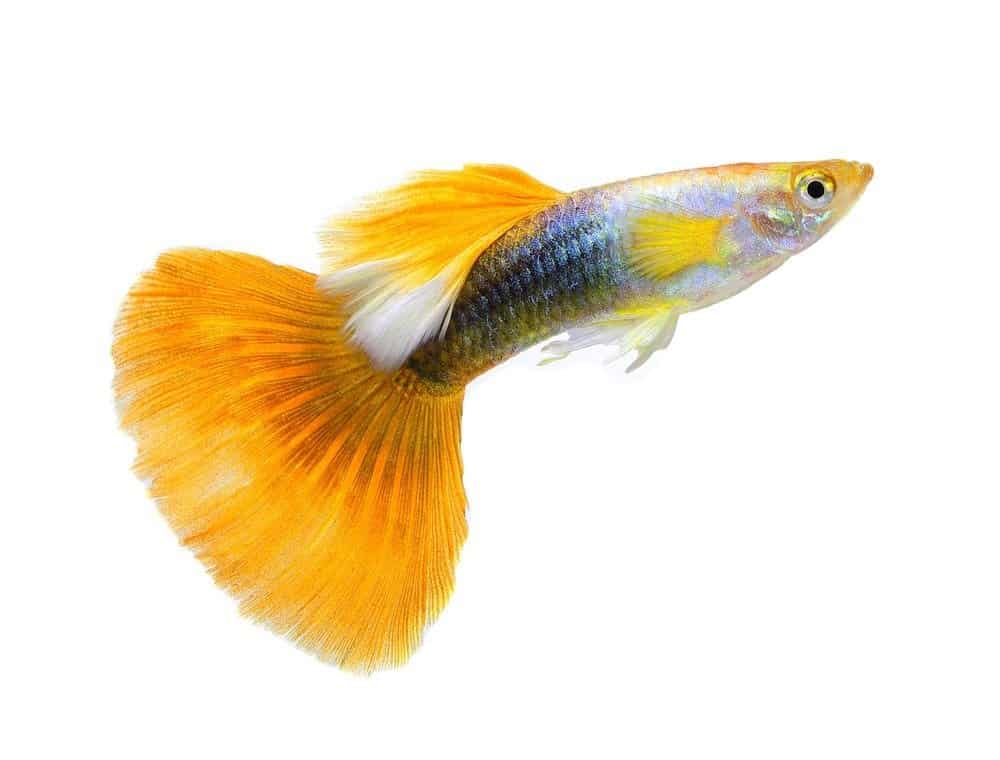
The guppy is a popular live-bearing fish that can be found in many different varieties.
©SOMMAI/Shutterstock.com
| Scientific name: | Poecilia reticulata |
| Origins: | Northeast South America |
| Lifespan: | 2 – 3 years |
| Minimum tank size: | 5 gallons |
| Diet: | Omnivore |
| Adult size: | 1.5 – 2.5 inches |
| Color forms: | Blue, red, orange, yellow, black, silver, white, gold, green, and pink. |
Important Considerations:
Before choosing a tank mate for guppies, the following factors need to be considered.
- Guppies require a minimum tank size of five gallons, although 10 gallons is ideal. Their tank size needs to be increased if you plan to keep them with other fish.
- Guppies are naturally social fish that form schools in the wild. They should never be housed alone or in pairs, and ideally in groups of six or more. They feel more secure in numbers and can get stressed easily by themselves.
- A heater and filter are a necessity for guppies. They are tropical fish that thrive at a temperature range between 72° to 82° Fahrenheit (22° to 27° Celsius).
- The best tank mates for guppies are other peaceful, tropical, social, and non-carnivorous fish or invertebrates similar in size. Their tank mates should be able to thrive in the same water conditions as guppies.
Now, let’s dive into the long list of compatible tank mates for guppies.
1. Mollies (Poecilia sphenops)
Mollies are a type of live-bearing fish in the same family as guppies. They grow to around 2 to 4 inches long and can be found in various colors, patterns, and fin shapes. Some of the most popular species of mollies are the balloon, sailfin, Yucatan lyretail, and shortfin, or common molly fish. Like guppies, mollies are tropical and freshwater fish that thrive at the same water parameters. When housing guppies and mollies together, the tank should be over 20 gallons in size. You will need to keep mollies in groups of four or more since they are social fish.
2. Mystery Snails (Pomacea bridgesii)
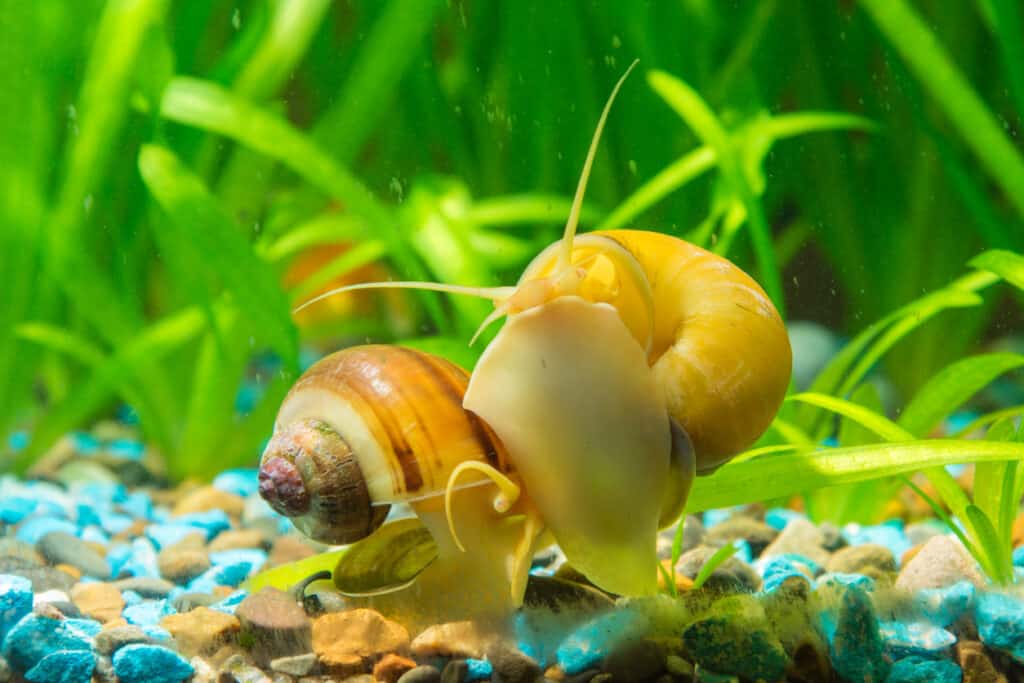
Gold is a popular shell color seen in mystery snails.
©iStock.com/Madhourse
Mystery snails and guppies are highly compatible since they are both peaceful and social. These snails grow to be 2 inches in size and live for around two years. You can find mystery snails in all sorts of colors, like baby blue, gold, chestnut, purple, and even pink. Mystery snails can either be housed in groups or alone since they do not need to be kept in groups. One or two mystery snails and a small group of guppies can be housed in a 10-gallon or larger tank.
3. Platies (Xiphophorus maculatus)
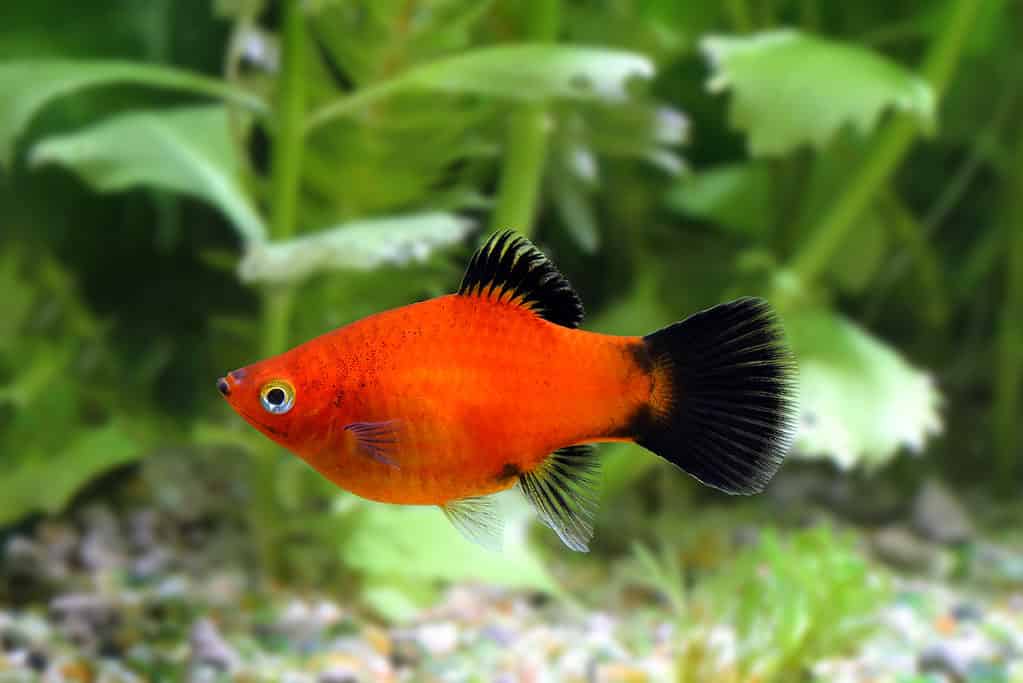
The southern platyfish has three dark circles at the base of their tail fin.
©topimages/Shutterstock.com
Platies are live-bearing fish often confused with mollies. Although both fish belong to the same family, platies are slightly smaller at only 3 inches long. There are different varieties of platies, although the southern platy is the most common and can be distinguished by three dark circles at the base of their tail. However, other varieties of platies can be housed with guppies, such as the wagtail, dalmatian, and calico platy. Both guppies and platies thrive at similar water parameters and require a heater to replicate the tropical conditions they experience in the wild.
If you decide to keep guppies and platies together, you will need to keep them in a spacious tank over 20 gallons in size. Just like mollies, platies need to be kept in groups of four or more as they are social fish.
4. Cory Catfish (Corydoras paleatus)
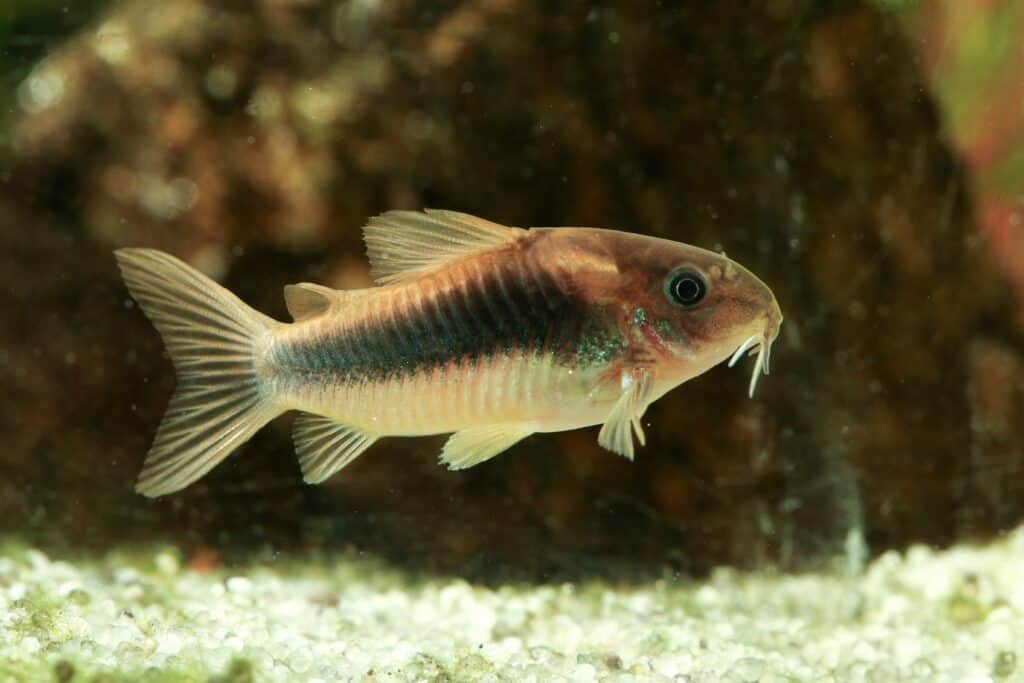
Like many
catfish
, bronze cory females are larger than males.
©Geza Farkas/Shutterstock.com
Cory catfish or corydoras are small bottom-dwelling fish in the Corydoras genus. Some of the most popular species include the albino, panda, peppered, pygmy, bronze, and green cory catfish. They reach an adult length of 1.5 to 4 inches, with the pygmy cory being the smallest out of all 160 recognized species.
Cory catfish spend most of their time at the bottom of the tank along the substrate, so they rarely interact with guppies. They mostly spend forage for food and socialize with their own species, since they need to be kept in large groups. You will need to keep cory catfish and guppies in a large, rectangular tank. Cory catfish do better in shallow tanks with more horizontal swimming space. You want to avoid keeping cory catfish in deep guppy tanks with more vertical swimming space.
You can keep a group of six guppies and cory catfish in a 25-gallon or larger tank. The tank needs to be heated and filtered, since guppies and cory catfish share similar water parameters.
5. Female Betta Fish (Betta splendens)
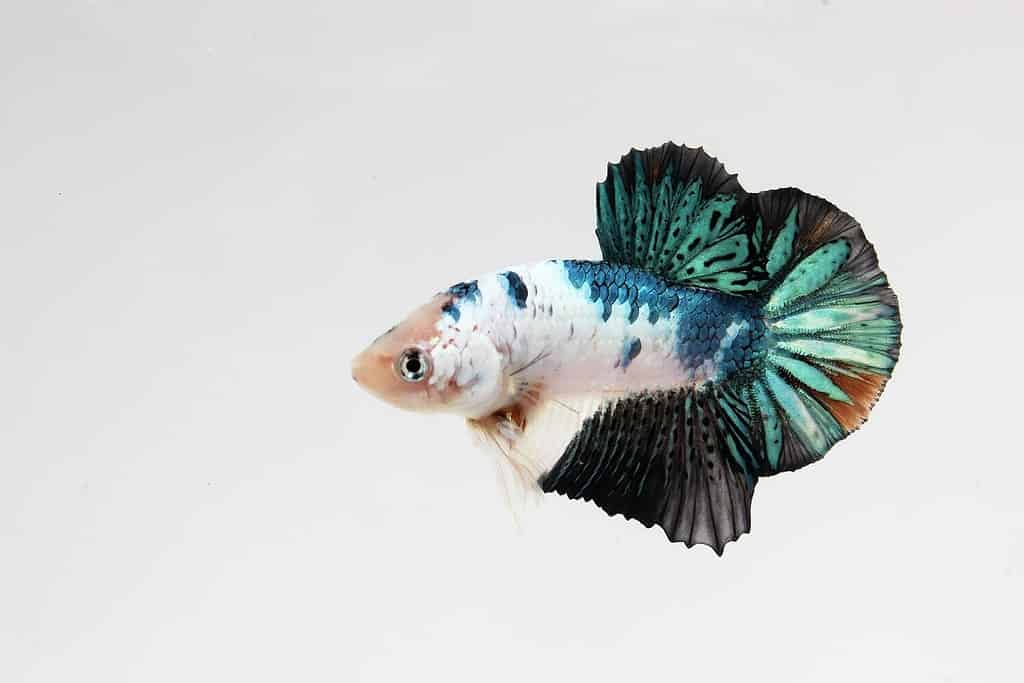
Male betta fish are highly territorial and should never be housed with other betta fish.
©Benzstock/Shutterstock.com
Bettas or Siamese fighting fish are very popular and colorful aquarium fish. They make excellent additions to tropical and freshwater aquariums over 5 gallons in size. Although male bettas are highly territorial and aggressive fish that are compatible with few tank mates, females are an exception.
Provided that the tank is spacious enough, female bettas could be housed with a small group of guppies. You ideally want to keep them with varieties of guppies that have short tails, since long and flowing tails might be tempting for bettas to nip at.
If you decide to keep a female betta with a group of guppies, be sure to keep the tank heavily planted. Guppies need a space to hide away if the female betta fish starts to show territorial behavior. Plants like hornwort, water sprite, and java moss are excellent choices.
6. Bristlenose Plecostomus (Ancistrus cirrhosis)
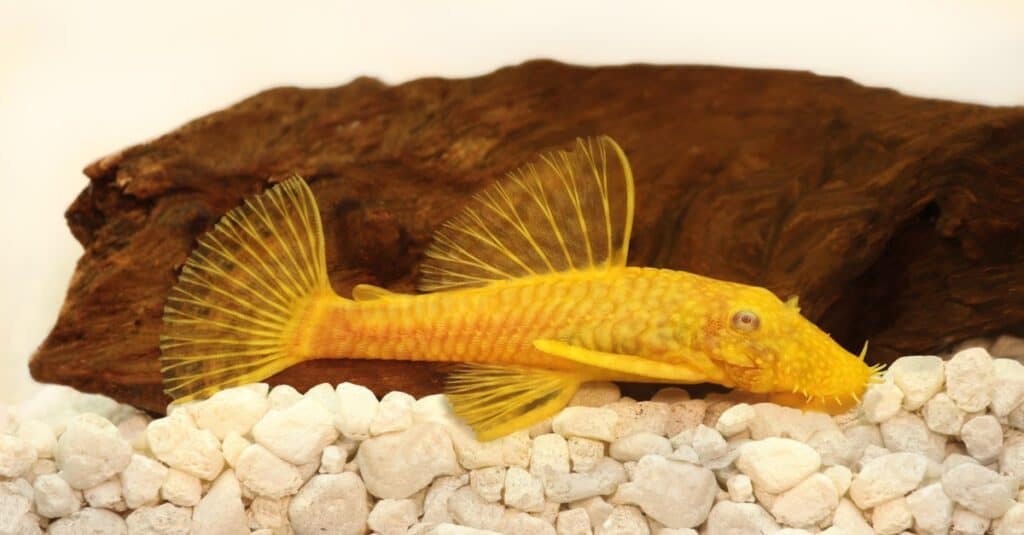
The bristlenose pleco is popular among the smallest pleco fish.
©iStock.com/Mirko_Rosenau
The bristlenose pleco, also known as the bushynose pleco, is a small species of Plecostomus that reach 5 inches in length. They naturally inhabit the tropical streams and tributaries in the Amazon River Basin, where they experience similar conditions as guppies. Bristlenose plecos can be distinguished by the thick tentacles (or barbels) that frame their heads. However, males have more prominent tentacles since they are a sexually dimorphic species.
They primarily inhabit the bottom of an aquarium or suction to the décor and sides of the tank with their suckermouths. Bristlenose plecos can be great additions to large guppy tanks over 25 gallons in size. You do not need to keep bristlenose plecos together since they are mostly solitary fish.
7. Dwarf Gourami (Trichogaster lalius)
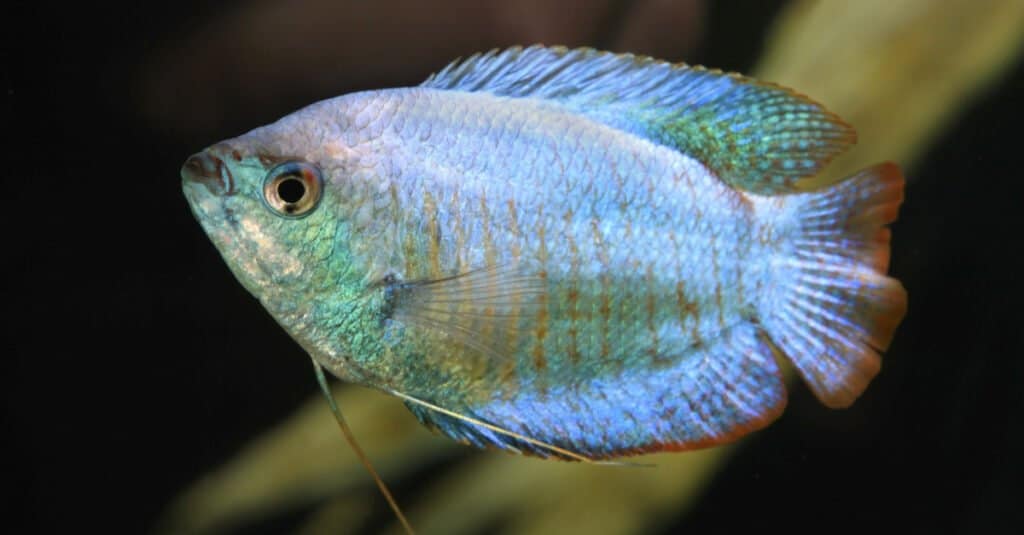
The dwarf gourami is a popular aquarium fish and comes in many colors.
©Steve Bower/Shutterstock.com
Dwarf gourami are very colorful freshwater that fish make popular additions to tropical and freshwater aquariums. They are available in several color variations, including blue, green, sunset orange, red, and rainbow. Most dwarf gourami are small at only 2 to 5 inches long, but usually not large enough to eat guppies. However, you should still be cautious about housing small juvenile guppies in the same tank as adult dwarf gourami.
This small fish is known for being relatively peaceful, which makes them compatible with guppies. You should aim to keep four or more dwarf gourami together, ideally with more males than females in the group. They are social fish that need to be kept with their own kind and can get stressed alone.
Due to their body and group size, dwarf gourami and guppies should be housed in tanks over 28 gallons in size.
8. Siamese Algae Eater (Crossocheilus oblongus)
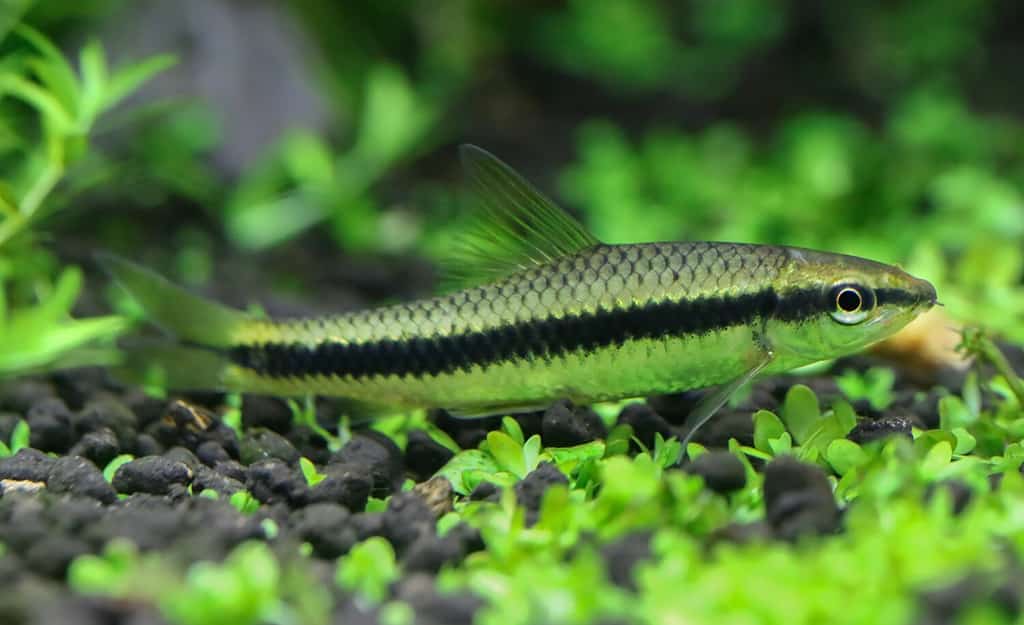
The Siamese algae eater thrives in heavily planted aquariums with heaters.
©Swapan Photography/Shutterstock.com
Siamese algae eaters are a type of freshwater fish that is native to Southeast Asia. They belong to the carp fish family (Cyrpinidae) and grow between 5 to 6 inches in length. They aren’t very colorful fish, with adults being a drab brown and yellow coloration. Their bodies are pencil-thin, and they have small downturned mouths that they use to suction for food. They are ideal for guppies’ aquariums with frequent algae growth since algae is a major source of nutrients for them.
Both guppies and Siamese algae eaters are peaceful and social fish that thrive in similar environments. The Siamese algae eater is also a tropical fish and can be kept within the same temperature range as guppies. However, they do require a spacious tank of over 30 gallons.
As social fish, Siamese algae eaters need to be kept in groups of four or more, with six being ideal.
9. Swordtails (Xiphophorus helleri)
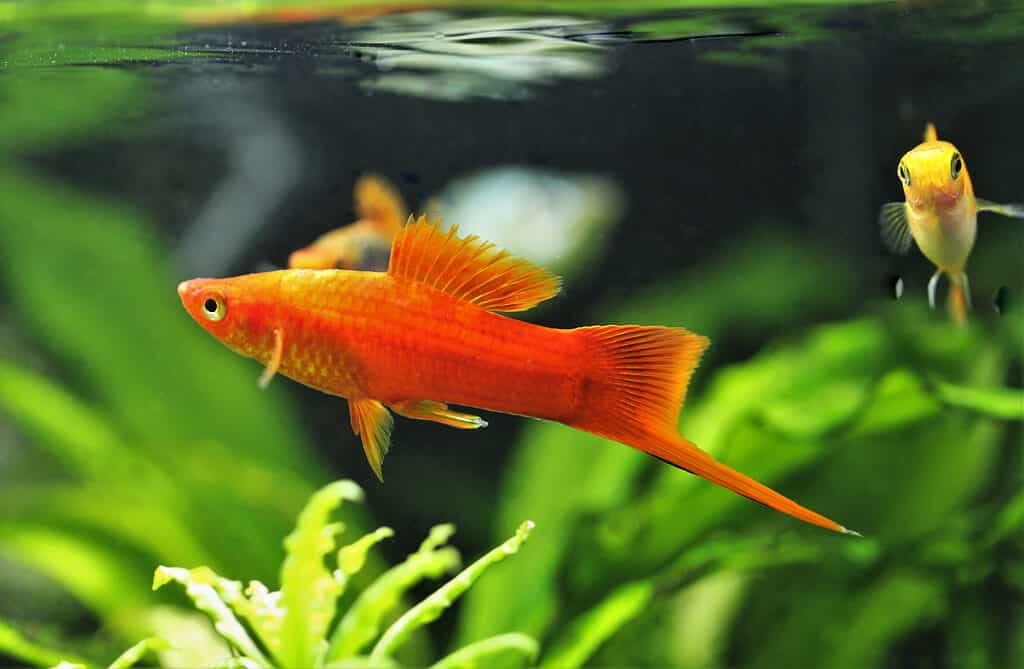
Male swordtails have a tail extension that looks like a sword.
©Arunee Rodloy/Shutterstock.com
Just like the mollies and platies we discussed above; swordtails are another type of live-bearing fish belonging to the same family as guppies. They are the perfect additions to community aquariums with guppies and can be found in a range of colors. Male swordtails are easier to distinguish than females, as the males have an elongated tail as their common name suggests. Most swordtails grow no larger than 3 to 5 inches long, with females being slightly larger.
Swordtails can be found in many impressive color forms, with red, white, orange, and koi being popular. They share the same water parameters, diet, and social requirements as guppies. Swordtails are social and omnivorous fish that need to be kept in a tropical tank with optimal space for swimming. Like most live-bearing fish, the swordtail needs to be kept in groups to form schools.
10. Neon Tetras (Paracheirodon innesi)
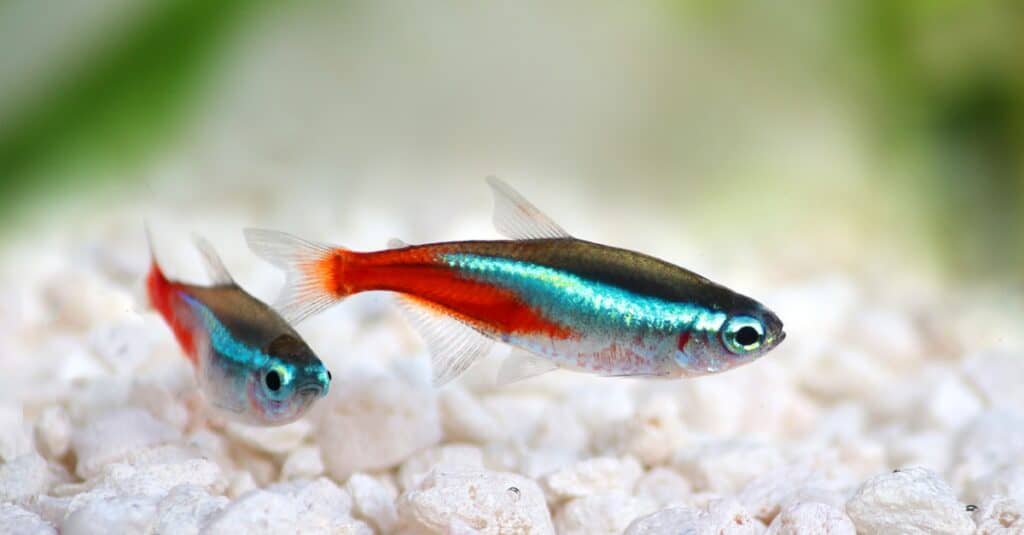
Neon tetras are one of the most vibrant tetra species.
©iStock.com/Mirko_Rosenau
The popular neon tetra is a very compatible tank mate for guppies and is often considered a first choice for beginners. Neon tetras are tiny schooling fish at only 1 to 2 inches in length. They have a distinctive neon red and white coloration and are known for being highly active and peaceful fish.
Neon tetras and guppies get along quite well, as both fish are social and rarely show signs of aggression. Furthermore, neon tetras are way too small to injure guppies. They are tropical fish that need to be kept in warm water like guppies, otherwise, they are at risk of certain diseases.
You can comfortably house a group of 6 to 8 neon tetras in a 10-gallon tank, but you will need to increase the size to 15 gallons when you add guppies. Neon tetras benefit from plenty of dense vegetation in an aquarium since it offers them a place to hide.
11. Neocaridina Shrimp (Neocaridina davidi)
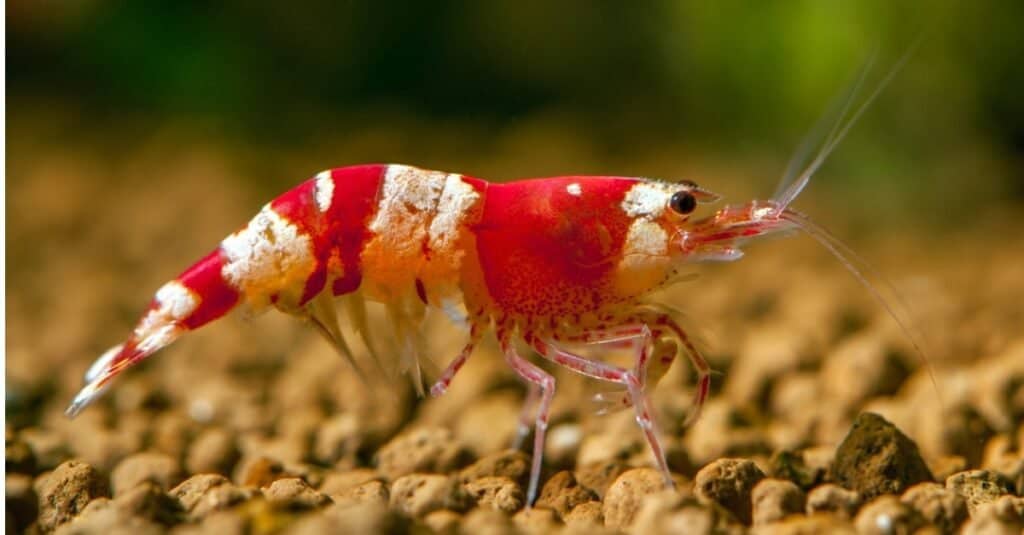
Neocaridina shrimp are tiny and can be found in many different colors.
©iStock.com/Mariusz-W
If you are interested in keeping shrimp with guppies, then neocaridina shrimp are a good choice. The cherry, red rili, blue dream, yellow, and jade green color forms are particularly compatible with guppies. Most neocaridina shrimp reach a size of 1 to 1.5 inches long and have a relatively short lifespan of only two years.
When keeping neocaridina shrimp with guppies, a tank setup is crucial. It is possible for guppies to try and eat neocaridina shrimp, especially when they are young. You will need to opt for a heavily planted tank setup filled with densely planted vegetation and plenty of driftwood and lava rock for them to hide in. The more places the shrimp have to hide in, the less likely they are to be eaten by guppies.
Neocaridina shrimp in general are very peaceful creatures and do not pose a risk to guppies in any way. You ideally want to keep neocaridina shrimp in large groups, since this makes them feel safer and encourages breeding. Their temperature range is similar to guppies, but they can tolerate cold water temperatures to around 59 degrees Fahrenheit.
12. Freshwater Angelfish (Pterophyllum scalare)
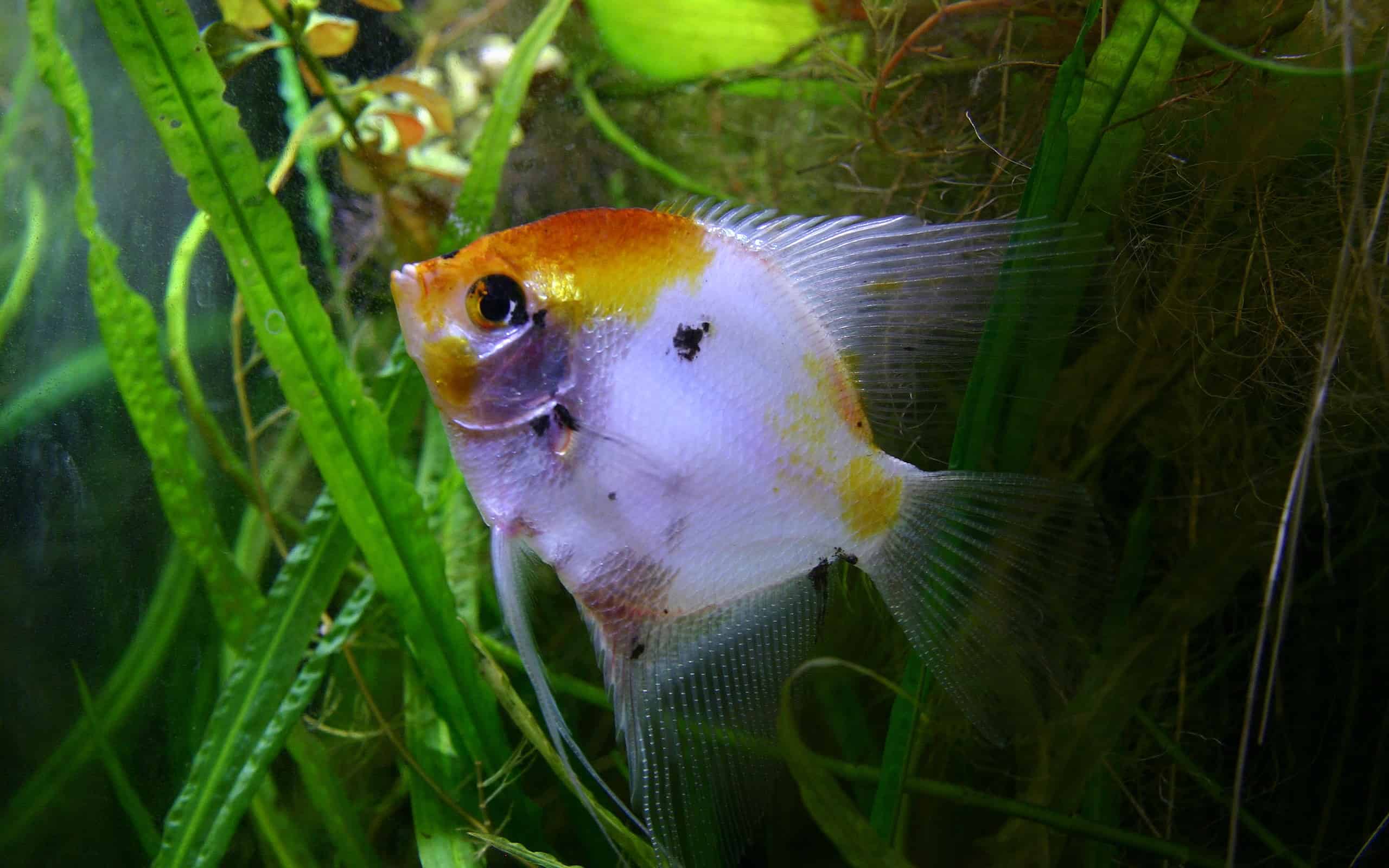
There are two types of
angelfish
: marine and freshwater.
©Visa Kopu, Roxeteer / CC BY-SA 3.0 – License
Freshwater angelfish are incredibly popular additions to freshwater community aquariums, including ones with adult guppies. Most small freshwater angelfish around 3 to 5 inches in size are compatible with guppies. There is some concern over adult angelfish eating guppies, but this can be avoided by keeping the tank spacious and heavily planted. You probably want to avoid housing small guppies or their fry in the same tank as freshwater angelfish to lower the risk of them being eaten.
There are plenty of angelfish varieties to choose from, with marbled, veil, zebra, and black lace angelfish being popular choices. Freshwater angelfish have similar water conditions as guppies, so the aquarium needs to be heated and filtered. Since angelfish are social, you should aim to keep them in groups of five or more.
Tank size is important when housing angelfish and guppies together since angelfish need plenty of swim space. A tank over 30 gallons in size is recommended for small groups of guppies and juvenile angelfish.
13. Harlequin Rasboras (Trigonostigma heteromorpha)
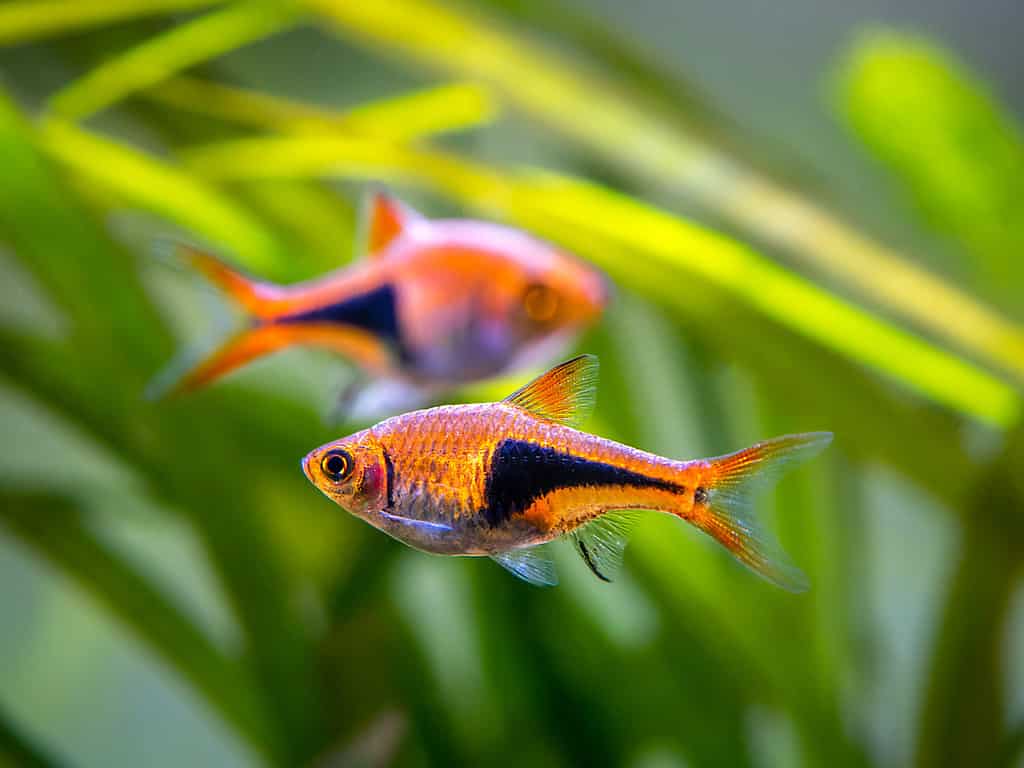
Rasboras are vibrantly colored fish with striking orange bodies.
©Joan Carles Juarez/Shutterstock.com
Harlequin or red rasboras and guppies are both highly social fish with peaceful temperaments and similar water conditions. The harlequin rasbora originates from the tropical rivers and streams of Southeast Asia like Thailand and Sumatra. They only grow to around 1.5 to 2 inches in length like the guppy. Harlequin rasboras have a distinctive red or copper-colored body with a dark black wedge starting at the middle of their body till the end of their caudal (tail) fin.
14. Rummy Nose Tetra (Hemigrammus Bleheri)
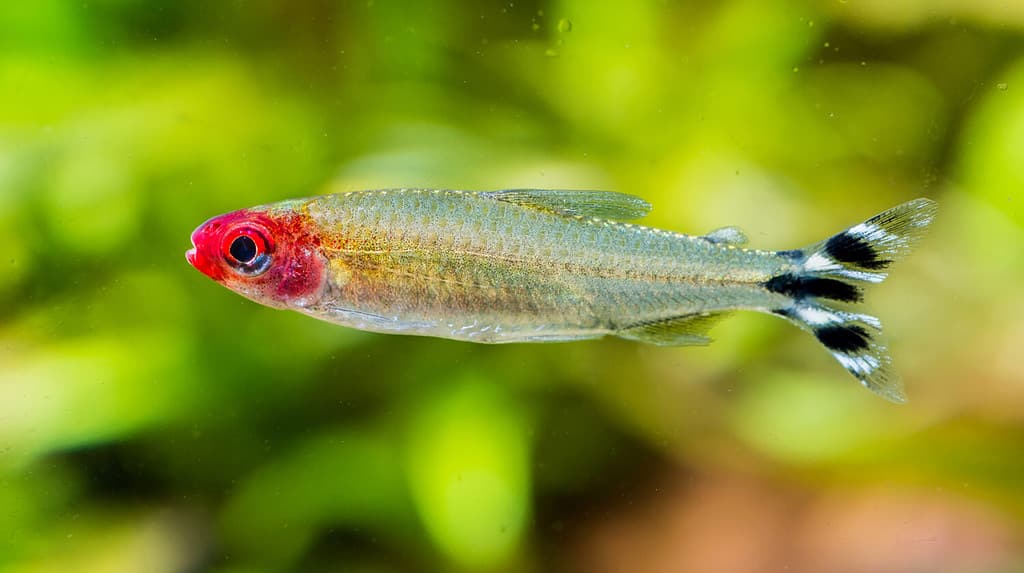
The rummy nose tetra can be distinguished by their blood-red faces.
©Ian Grainger/Shutterstock.com
Rummy nose tetras are small, peaceful, and social fish that make excellent additions to freshwater community aquariums. They have a vibrant yellow body with a dark red head and black and white spotted tail fin. They are not very large fish at only 2 inches in size. Rummy nose tetras thrive in heavily planted tank setups with a filter and a heater, since they are tropical fish.
It is essential to keep rummy nose tetras in groups of six or more as they are highly social fish. You can keep a group of rummy nose tetras and guppies in a tank of around 20 gallons in size. Both guppies and rummy nose tetras swim at the same level in an aquarium that is near the middle and surface.
15. Zebra Danios (Brachydanio rerio)
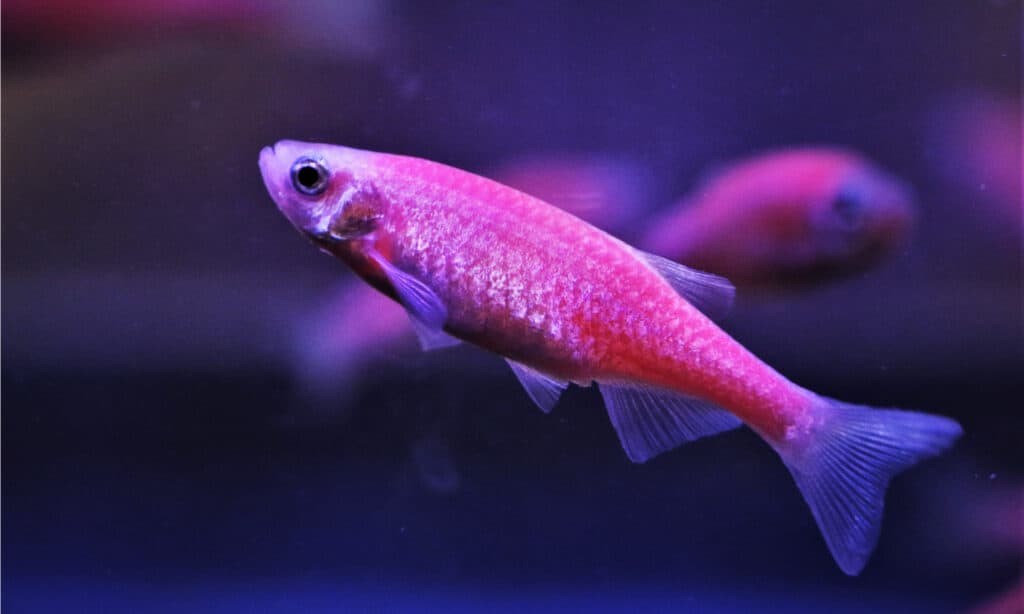
The pink zebra danio is a genetically modified zebrafish.
©Arunee Rodloy/Shutterstock.com
The popular freshwater fish – the zebra danio, is slightly smaller than guppies but makes good tank mates. Zebra danios are tiny peaceful fish that form large schools in the wild and in aquariums. They reach a length of 1 to 2 inches as an adult and have the opportunity to live up to 3 years with proper care.
The zebra danios’ appearance can vary since they mostly have a blue and yellow striped body. However, some zebra danios have been genetically modified to have neon purple, blue, green, yellow, pink, and red colors. Zebra danios can also be albino, but they aren’t as popular as the brightly colored varieties.
All varieties of zebra danio are social schooling fish, so they need to be kept in groups of six or more. They get along quite well in the same tank as guppies and share many things in common, such as their diet, water temperature, and peaceful temperament.
Since zebra danios are small fish, they do not require very big tank setups. You can keep a handful of guppies and zebra danios in a 15-gallon or larger tank. Live plants like Amazon sword, floating hornwort, and water sprite are preferred over fake plants.
16. Ember Tetra (Hyphessobrycon amandae)
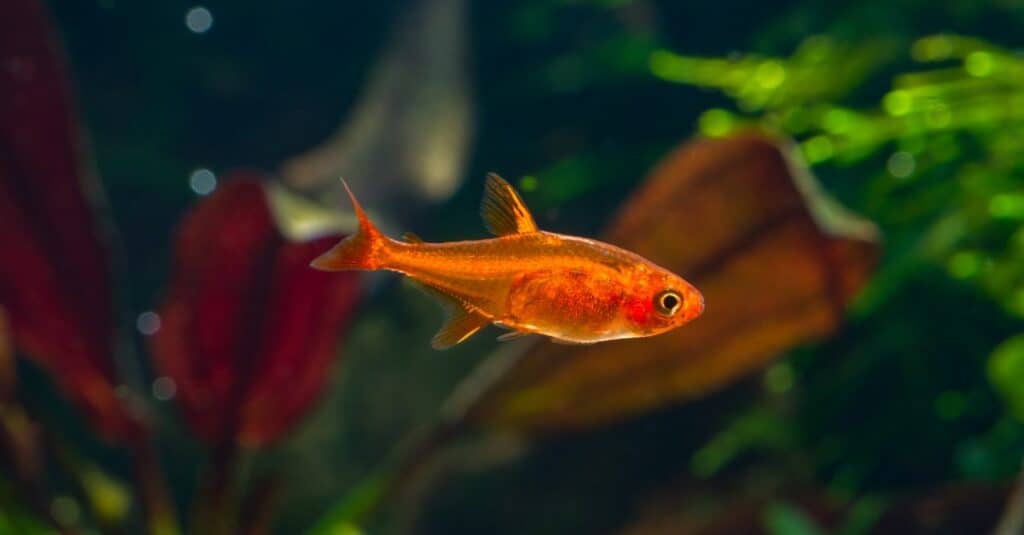
Despite its small size, the ember tetra stands out thanks to its striking coloration.
©iStock.com/[email protected]
The ember tetra’s fiery red coloration and timid temperament make them a favored guppy tank mate. Ember tetras originate from Brazil where they inhabit the freshwaters of the Araguaia River Basin. You can keep a group of six ember tetras and guppies in a 20-gallon tank, ideally with plenty of live plants and even driftwood.
Ember tetras only reach 1 to 1.5 inches in size, so they are slightly smaller than most guppies. Furthermore, ember tetras have a short lifespan of only two to four years, which is similar to guppies. Ember tetras are relatively easy to care for, which makes them suitable for beginner guppy fish keepers. You can also keep ember tetras and guppies in the same tank as other compatible tank mates, such as mystery snails and live-bearing fishes.
The key to keeping ember tetras and guppies thriving in a community is good water quality. Both are tropical fish that live in freshwater aquariums with no traces of ammonia or nitrite.
17. Cardinal Tetra (Paracheirodon axelrodi)
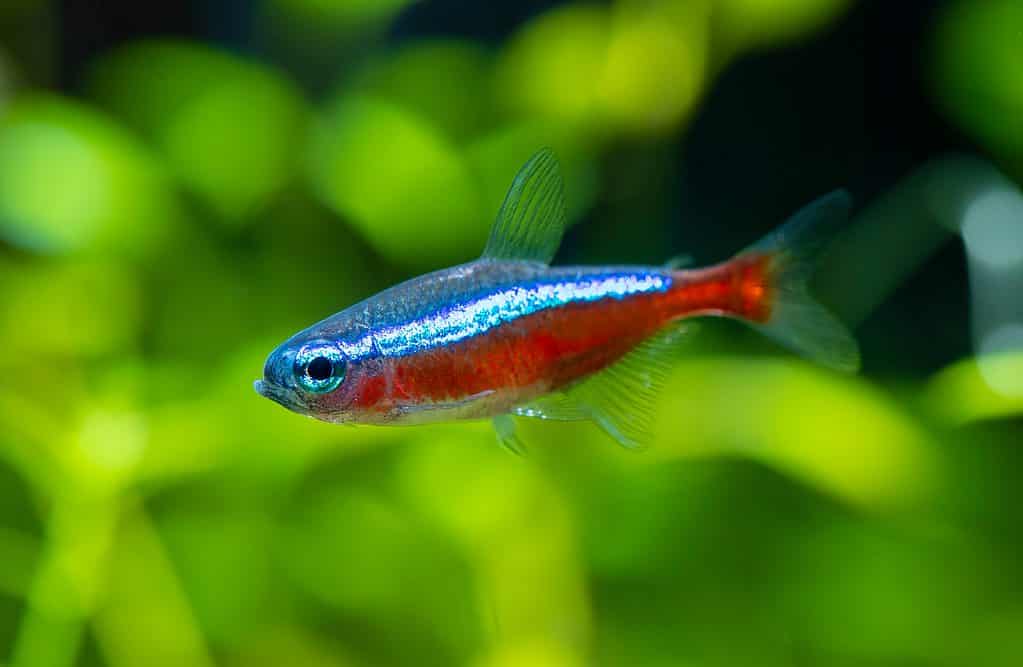
Cardinal tetras have a fuller red coloration than neon tetras.
©NattapolStudiO/Shutterstock.com
At first glance, you might mistake a cardinal tetra for a neon tetra. Both fish look very similar, but there are some key differences. Cardinal tetras are larger than neon tetras at 2 inches in length. They have a slimmer appearance and red coloration below a neon blue stripe, whereas the neon tetras red markings stop midway.
Cardinal tetras thrive in tropical freshwater aquariums with plenty of live plants. They enjoy swimming amongst the plants that grow near the middle and surface of the aquarium since this is where they swim the most. Guppies and cardinal tetras are highly compatible and have few issues when housed together. Aside from neon tetras, cardinal tetras are another top tank mate for guppies.
18. Dwarf Neon Rainbowfish (Melanotaenia Praecox)
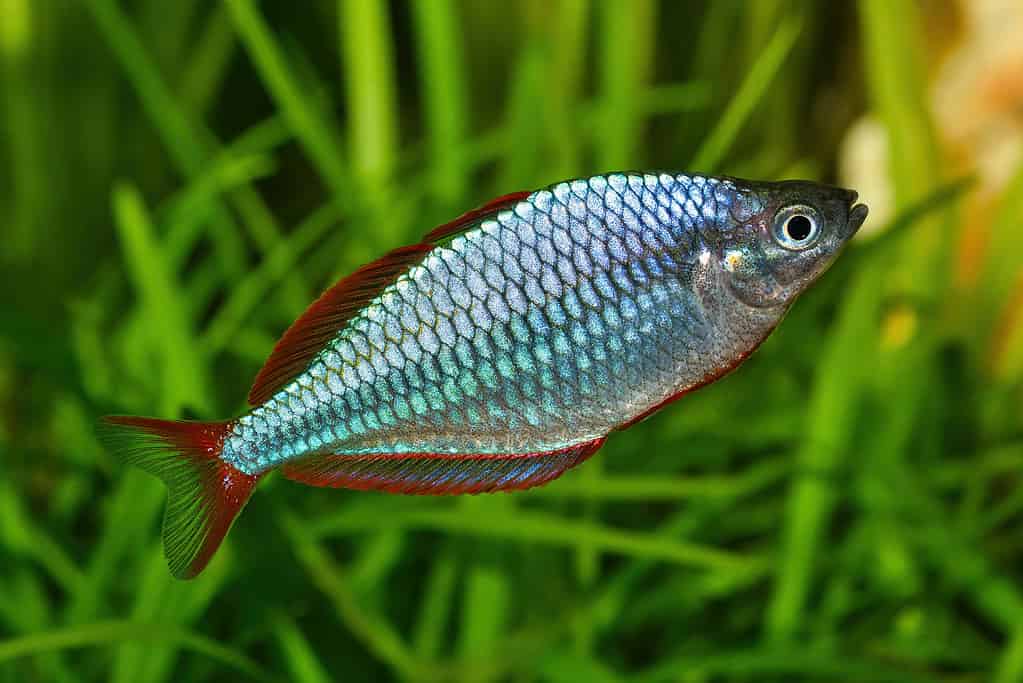
Neon dwarf rainbowfish have striking iridescent bodies that liven up guppy aquariums.
©iStock.com/NERYX
The stunning dwarf neon rainbowfish is often overlooked as a tank mate for guppies. However, they are compatible fish that have similar care requirements and tank setups. The dwarf neon rainbowfish is true to their name at only 3 inches long.
They have an almond-shaped body framed with vividly red fins. The females can be distinguished by more yellowish fins. The most classic feature of the dwarf neon rainbowfish is their blue bodies with multi-colored iridescence. Their bodies shine under bright aquarium lighting and pair strikingly with guppies.
If the tank is large enough (ideally more than 25 gallons), dwarf neon rainbowfish can be kept with guppies to liven up the aquarium.
19. Nerite Snails (Neritina Natalensis)

Nerite snails are preferred by many aquarists since they cannot reproduce in freshwater.
©iStock.com/Juan Carlos Juarez Jaramillo
If you want a non-fish tank mate for your guppy but don’t want to deal with the breeding habits of other aquarium snails, the nerite snail is a good choice. Nerites are brackish and freshwater snails that originate from the coastal waters in Africa, and from parts of the Pacific Ocean.
Although nerite snails can live in freshwater aquariums, their eggs cannot hatch without brackish waters. They rely on water with a higher salinity content than guppies to reproduce. This means that you can successfully keep guppies and nerites together without worrying about dealing with hundreds of baby snails.
Furthermore, nerite snails are small at only 0.5 to 1 inch long. They are available in different color forms, such as striped, green, yellow, brown, black, and orange. You do not need to keep nerite snails in groups, although it is preferred if you want to see them more often.
20. Otocinclus Catfish (Otocinclus cocama)
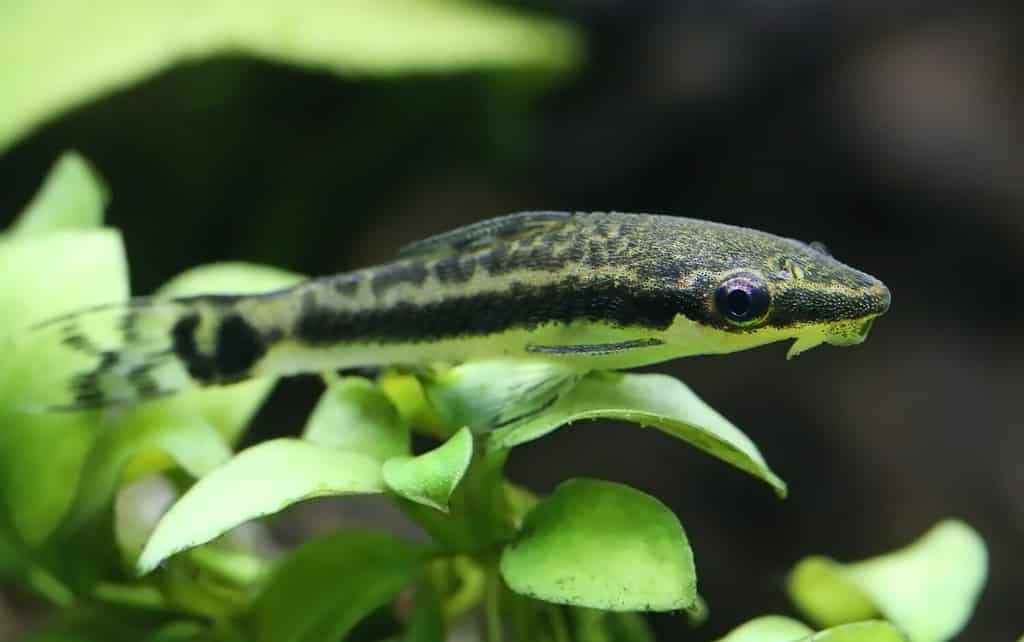
Otocinclus are small catfish that are sometimes mistaken for Siamese algae eaters.
©Swapan Photography/Shutterstock.com
The Otocinclus or oto for short, is a tiny catfish belonging to the Loricarlidae family. Oto catfish have an average length of 2 inches and have a yellow to brown-grey body coloration. They have a suckermouth that they use to attach themselves to plants, tank glass rocks, and various décor.
Most oto catfish are peaceful, social, and shy fish that keep to themselves in an aquarium. They need to be kept in groups of five or more as social fish and make good tank mates for guppies and other peaceful fish. You ideally want to keep them in tanks around 20 gallons in size since both oto catfish and guppies are in sufficient swim space to thrive. Of course, a heater and filter are essential for oto catfish as they are tropical fish.
21. Kuhli Loaches (Pangio kuhlii)
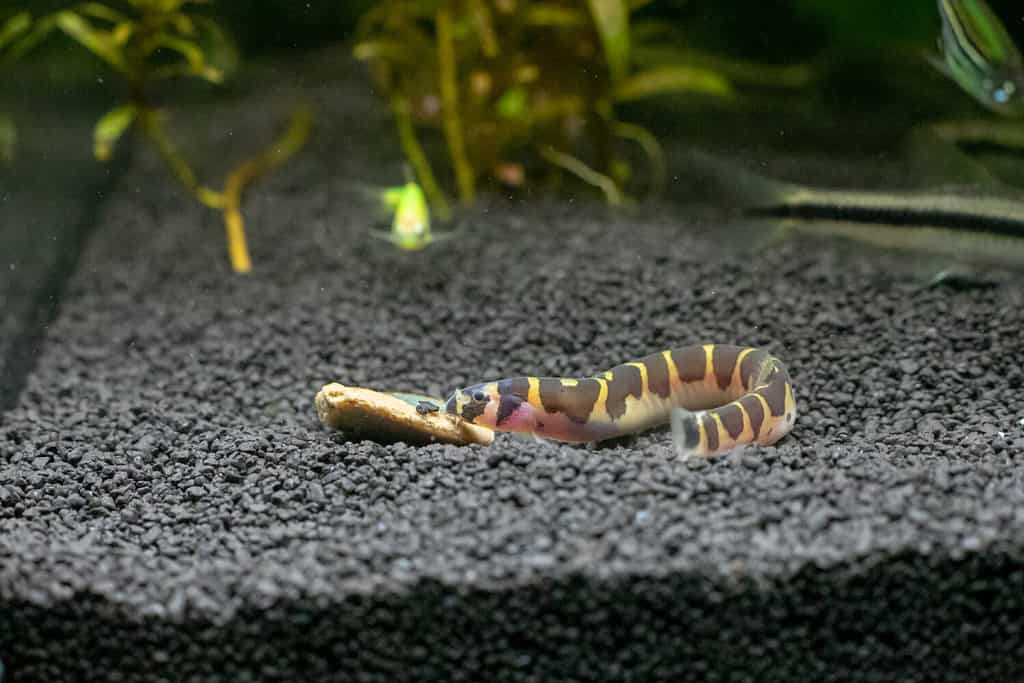
Kuhli loaches resemble eels and have eel-like movements in the water.
©Olga Chezhina/Shutterstock.com
The last best tank mate for guppies happens to be the Kuhli loach. These are active and social fish that have distinctive eel-like bodies. They do not swim in the same manner as other schooling fish and prefer to burrow into the substrate or hide amongst plants and rocks. Kuhli loaches originate from the tropical and freshwater streams of Southeast Asia. They can vary in appearance but usually have a striped body or a plain brown or beige color. Kuhli loaches can grow to 4 inches long as an adult.
As highly social fish, Kuhli loaches need to be kept in groups of five or more. Their peaceful temperaments make them compatible with guppies, and both fish can be housed in planted tanks over 20 gallons in size. You will need to ensure that your guppy’s tank has a sandy or fine quartz substrate for Kuhli loaches. They are burrowers and can get injured by pebbles or gravel-like substrates.
Guppy Tank Mates to Avoid
The following tank mates are not compatible with guppies and should never be housed together. They are either too large, aggressive or do not require similar water conditions to guppies.
- Goldfish
- Koi
- Male betta fish
- Jack Dempsey
- Oscars
- Dwarf pufferfish
- African cichlids
- Tiger barbs
- Killifish
- Turtles
- Any marine species.
Summary of the 21 Best Tank Mates for Guppies
| Rank | Tank Mate |
|---|---|
| 1 | Mollies |
| 2 | Mystery snails |
| 3 | Platies |
| 4 | Cory catfish |
| 5 | Female betta fish |
| 6 | Bristlenose Plecostomus |
| 7 | Dwarf gourami |
| 8 | Siamese algae eater |
| 9 | Swordtails |
| 10 | Neon tetras |
| 11 | Neocaridina shrimp |
| 12 | Freshwater angelfish |
| 13 | Harlequin rasboras |
| 14 | Rummy Nose tetra |
| 15 | Zebra danios |
| 16 | Ember tetra |
| 17 | Cardinal tetras |
| 18 | Dwarf neon rainbowfish |
| 19 | Nerite snails |
| 20 | Otocinclus catfish |
| 21 | Kuhli loaches |
The photo featured at the top of this post is © panpilai paipa/Shutterstock.com
Thank you for reading! Have some feedback for us? Contact the AZ Animals editorial team.




